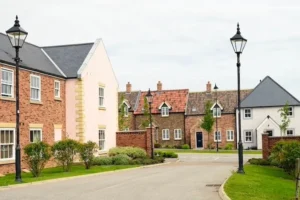London’s architecture is not just a collection of buildings but a profound narrative etched in stone, glass, and steel. The city’s skyline tells a tale of cultural evolution and historical transitions, showcasing how a dynamic blend of influences has shaped one of the world’s most iconic urban landscapes. From medieval fortresses to modern skyscrapers, architecture in London vividly reflects its diverse history and multicultural essence.
Medieval Foundations and Tudor Heritage
The roots of London’s architectural heritage can be traced back to its medieval beginnings. Landmarks such as the Tower of London and Westminster Abbey offer glimpses into the city’s early history. The Tower of London, originally built by William the Conqueror in 1066, is a symbol of Norman power and medieval fortification. Its sturdy, imposing design reflects the turbulent times of its construction, serving both as a royal palace and a fortress.
Similarly, Westminster Abbey, a masterpiece of Gothic architecture, embodies the grandeur and religious significance of medieval London. Its intricate details and soaring spires capture the spiritual and cultural ambitions of the era. The abbey has been the site of numerous royal ceremonies, from coronations to weddings, emphasizing the deep connection between architecture and national identity.
The Renaissance and Baroque Influences
As London transitioned from the medieval period to the Renaissance, its architecture began to reflect new artistic and cultural influences. The rebuilding of St. Paul’s Cathedral by Sir Christopher Wren after the Great Fire of London in 1666 is a prime example of this transformation. Wren’s design, characterized by its elegant dome and classical proportions, marked a shift towards Baroque architecture. The cathedral not only symbolizes London’s recovery from disaster but also showcases the city’s embrace of Renaissance ideals of beauty and harmony.
The influence of the Renaissance extended to other parts of the city as well. Buildings such as the Royal Exchange and the Somerset House feature neoclassical designs that highlight the period’s emphasis on symmetry and proportion. These structures represent London’s growing importance as a global trading hub and cultural center.
Georgian Elegance and Victorian Ambition
The Georgian era brought a new level of sophistication to London’s architecture. The Georgian townhouses, with their harmonious facades and orderly streets, epitomize the elegance of this period. Areas like Bath and Bloomsbury are perfect examples of Georgian architecture, characterized by their uniformity and restrained grandeur. This style reflects the societal aspirations and aesthetic values of 18th-century London.
The Victorian era, on the other hand, was marked by a spirit of innovation and industrial progress. This period saw the construction of some of London’s most recognizable landmarks, such as the Houses of Parliament and the Natural History Museum. The Gothic Revival style of the Houses of Parliament, with its ornate detailing and dramatic spires, symbolizes the Victorian era’s fascination with medieval aesthetics and national pride.
The Crystal Palace, built for the Great Exhibition of 1851, represents another significant architectural milestone. Its use of glass and iron was groundbreaking at the time and reflects London’s role as a leader in industrial and technological advancements.
Modernist and Postmodernist Developments
As the 20th century unfolded, London’s architecture continued to evolve, embracing new styles and technologies. The post-war era saw the rise of Modernist architecture, with buildings like the Barbican Estate and the Southbank Centre showcasing sleek lines, functional design, and a focus on urban regeneration. The Barbican, in particular, is a testament to London’s commitment to creating expansive, multi-use complexes that integrate residential, cultural, and recreational spaces.
In recent decades, Postmodernism and contemporary architecture have made their mark on the city. Iconic structures such as The Shard and the Gherkin (30 St Mary Axe) stand as symbols of London’s forward-thinking ethos and global status. The Shard, designed by Renzo Piano, is a sleek, glass-clad skyscraper that reflects both the city’s modernity and its historical layers, offering panoramic views of London’s ever-changing skyline.
The Gherkin, with its distinctive cylindrical shape and eco-friendly design, highlights the integration of sustainability and innovation in contemporary architecture. These structures not only contribute to the city’s visual identity but also represent its ongoing transformation and adaptation to the needs of the 21st century.
A Reflection of Diversity
London’s architecture is a living record of its rich, multicultural history. The city’s buildings span a wide range of styles and influences, each reflecting different periods and cultural influences. This diversity is mirrored in areas such as Brick Lane, known for its vibrant mix of architectural styles and its role as a cultural melting pot.
In neighborhoods like Southall and Chinatown, the architectural styles by the top architecture firms in London reflect the rich tapestry of communities that have contributed to London’s cultural mosaic. Temples, mosques, and community centers showcase the city’s inclusivity and its celebration of cultural diversity.
Conclusion
London’s architecture is a dynamic reflection of its historical journey and cultural richness. From medieval fortresses to modern skyscrapers, each building tells a part of the city’s story, illustrating how diverse influences have shaped its urban landscape. As London continues to evolve, its architecture will undoubtedly keep capturing the essence of its past while embracing the future, maintaining its status as a city that honors its history and celebrates its diversity.

















